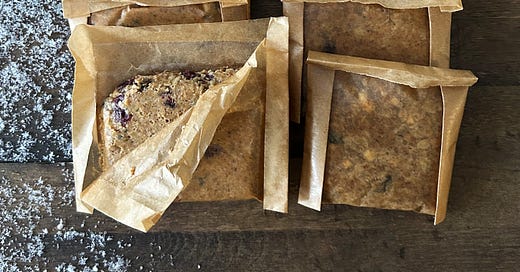
I moved to New York with just a suitcase and a Greyhound ticket. After several Greyhound trips and stays at hostels and the Greenpoint YMCA while interviewing after college, I was hired for an entry-level job at an arts marketing firm. It was far from glamorous, focused on audience data analysis and crafting acquisition, loyalty, and growth strategies, but it was a place to start.
In the whirlwind couple of weeks before my start date, I couldn’t find a permanent place to stay. It seemed that my budget would secure only a cubby with a mattress in a shared apartment. In a last-minute spark of luck and generosity one of the ladies I worked alongside as a local gallery assistant connected me with a friend — an artist building a collaborative art space that they hoped to invite artists in residence to in the future. I would be their first test resident! I boarded the bus with a phone number and hoped that I’d meet a new friend on the other side.
Justin met me along with gently falling snow at Port Authority. He escorted me back to Queens, back to a raw “artists’ live/work space” brimming with potential. At the upper floor of a textile factory, it was an enormous room with glass block windows spanning two walls. The bathroom and one source of running water was a utility space in the hall, shared with the other artists who shared the floor. Justin Penov and his co-creator and roommate, both talented young artists, had leased the space together a few months prior and were deep in the midst of transforming it from a company’s storage space into a livable workspace. They had created a makeshift kitchen in the corner on file cabinets and divided out rooms for themselves at opposite corners using found material and the divider for a tradeshow booth to create walls. They set up another room for me with scaffolding material, cleverly creating shelves by running boards across one side to fashion a closet. I rolled out my twin blowup mattress and unpacked my stacks of pants, shirts, and sweaters, feeling incredibly grateful to be welcomed into this creative community and warm home.
I was awakened the next morning from a deep sleep by the softly diffused glow of the rising sun through the glass block windows. It was a warm light of possibility, the kind that inspires songbirds, the kind that beckons you forward to start building the version of the future you can only hope for in dreams.

It takes courage and luck to make big life changes — to start working toward a new goal, project, or future. The spark of inspiration may come as easily as setting a goal or stating a New Year’s Resolution, but building a fire requires the right conditions — those you create for yourself, and those offered by a supportive environment and community. New beginnings are hard not just because they require outlining and the steps toward your goal and working toward them with persistence and resilience when things get challenging. The most difficult parts of the process are the physical, mental, and emotional work to create space for change. It’s real work to identify the essentials you need to sustain your life and set aside the rest so you can focus on building something new. That extends to how we feed ourselves.
While moving, traveling, adjusting to a new routine, or to new life circumstances it’s helpful to have a few formulas for feeding yourself in mind. Limitations inspire creativity, whether that means going without options for cooking, refrigeration, prep space, familiar and preferred ingredients, or financial resources. During college and when I first moved to NYC, the ways I few myself included a handful of inexpensive restaurant options (day-old bagels and bread, pizza by the slice, falafel sandwiches, noodles), Clif Bars, a few minimal grocery meals, and my go-to meal of peanut butter sandwiches. A loaf of bread or bag of day-old bagels and a jar of nut butter could get me through a week, if not in an ideal state, at least reasonably satiated. Justin introduced me to his ingenious upgrade, adding a handful of trail mix. It takes a classic and makes it a textural delight open to possibility by varying the ingredients. I’ve broken it down as a basic formula for your own perspective, creativity, and experimentation below.


It was cold that winter. No heat on Sundays. Your hospitality kept me warm. We gathered around the fire of new beginnings. The flames held visions, both yours and mine — of a community space for art, of art created in community, of being in community with art. I came in need of support, ready to support. You gave me yours — a room built of scaffolding, a prototype, a place to start.
The vision called out, “Strip back to the essential. Keep only the necessary. Clean away the broken and dirty remnants of the past. Start with a light suitcase — a clean space to fill. The pain of burning away makes space for growing the new.”
Light come softly, come gently in morning. Illuminate this space. Clarify the path forward. Warm our hands for the tasks to be done. Prepare us for a day spent pushing through crowds of resistance — conflicting needs to sustain and to grow.
“Go lightly, with eyes lifted and open. Go boldly, with visions for a future, beautiful and true. Go with the momentum of possibility. Go with creators on the same path. Go now, before the moment has passed. There’s no guarantee of space on the next train.”
We rode home again at sunset, past 5Pointz — a 7 train beacon after emerging from the depths. Screeching wheels around the bend and the clickety-clack percussion that took us forward brought us home.
With ready hands to build a beautiful future,
From the Table

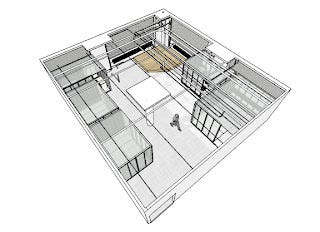
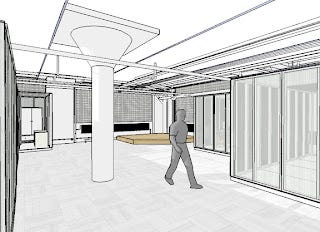


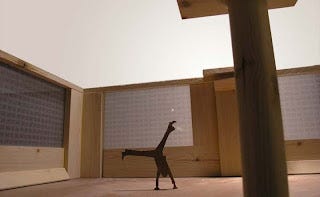


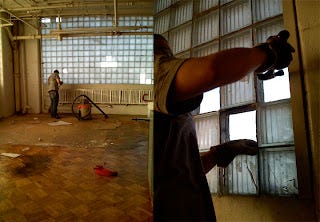






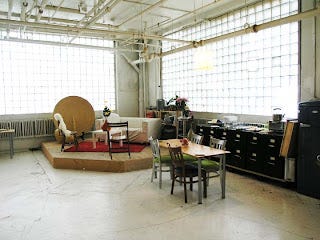


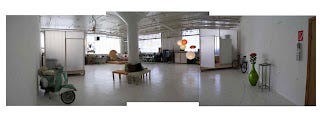

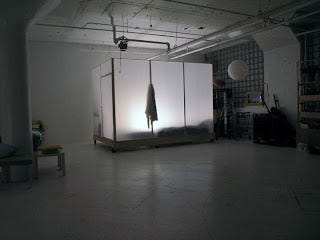
Read more about the creation of Softbox art space here. Their pod design was an inspiration for a room divider my husband and I created as we were iterating through solutions in our own loft apartment space some years later.
Justin went on to co-found another wonderful art and performance space in LIC, The Texas Firehouse, which you can read about here.
An Invitation to Write…
Who supported you through a pivotal new beginning?

Trail Mix Sandwiches — a formula more than a recipe
No kitchen? No problem. It’s helpful to have a few basic ways to keep yourself fed with minimal time and resources. Peanut butter sandwiches have been my go-to since elementary school. I’m sure I’m not alone in having them as a favorite survival meal. My friend, Justin Penov, introduced me to the concept of a peanut butter and trail mix sandwich — a game changer in thinking about a peanut butter sandwich as a creative medium. Think about it — just a handful of trail mix and a basic sandwich becomes a salty, sweet, crunchy quick lunch.
When you break it down as a formula, the possibilities are limitless. Any bready medium (or crackers), spread with a something smooth, can be brought to life with a sweet or savory pairing, something crunchy to add texture, and a sprinkle of seasoning to bring it all together. Choose shelf-stable ingredients like nut butter, dried fruit, seeds, nuts, and spices for the times when you don’t have access to refrigeration.
Makes 1 Sandwich
Prep Time: < 5 min.
Ingredients:
2 slices of bread
Nut or seed butter, or a similar spread
Something sweet or savory
Something crunchy
A little extra flavor (optional)
A Few Potential Combinations:
Almond butter (smooth), dried berries, hemp and chia seeds
Peanut butter (crunchy), banana chips, raisins, cinnamon
Tahini (just a bit), dried figs and dates
Avocado, French’s fried onions, sprouts, everything bagel seasoning
Preparation:
Set out 2 slices of bread. Slice, split, toast, or just lay them out on a clean surface.
Spread with nut or seed butter. Spread a layer of your favorite on one slice or both if you require extra stickiness to contain your sandwich fillings.
Sprinkle with flavorful and textural sandwich fillings. Choose a complementary combination of sweet, salty, savory, and/or spicy fillings. Fruit, nuts, seeds, granola, chili crisp, spices, or sprouts could all be fair game. Let your cravings and whatever you have available guide you.
Sandwich and eat or pack to go. Enclose your fillings between the bread slices. Cut and eat, or wrap it up to take with you wherever the day and the trail lead.
Trail Mix Bars
Have a bowl and a spoon? These are like a no-bake Clif Bar that you can fashion in any way you like for a quick meal on the go. The basic recipe is adapted from the No Bake Energy Bites recipe on Trader Joe’s Flaxseed Meal bag into something a little less sweet and more portable. Much like Trail Mix Sandwiches, use this like a basic formula for creating your own favorite flavor combinations.
Note: You can make this without measuring cups by using the basic ratio: 1 part flaxseed meal, 2 parts each oats, nut butter, and mix-ins, plus seasonings to taste.
Makes ~12 bars
Prep Time: ~10-15 min.
Ingredients:
1 cup rolled oats
1/2 cup flaxseed meal
1 cup smooth nut or seed butter, or a similar spread
1 cup dried fruit, nuts, chocolate, and/or seeds
1-2 Tbsp coconut sugar (optional)
A sprinkle of something flavorful (optional)
A Few Potential Combinations:
Almond butter, dried cranberries, pumpkin seeds
Peanut butter, cacao nibs, crushed banana chips
Sunflower seed butter, dried apple bits, chia seeds, cinnamon
Tools:
Bowl
Spoon
Sheets of parchment or wax paper cut into ~ 6x8” rectangles or beeswax wrappers
Rubber bands or twine (optional)
Preparation:
Cut or tear 6x8” rectangles of parchment or wax paper. This is the equivalent of tearing a half sheet pan sized sheet of parchment paper into quarters. If you use beeswax food wrappers, rectangles of roughly the same size will work here, too.
Fold the wrappers into pockets. Fold up along the length of the rectangle into roughly a 4x6” rectangle. Then, fold over roughly 1/4” on each of the longer sides, creasing and repeating on either side. You’re aiming to have a secure pocket that you can hold open in an encircled hand.
Measure all your ingredients into a bowl. Pour in the oats, flaxseed meal, nut butter, mix-ins, coconut sugar (if you’d like more sweetness), and any other seasonings.
Stir them all together. Your mix will come together as a dough that barely holds together but should form a tight ball if you press it together in a spoon or in the palm of your hand. Add more oats and flaxseed or nut butter to adjust the texture. Taste and adjust the flavor with additional coconut sugar, salt, fruit, nuts, seeds, or any other seasonings.
Scoop dough into the wrapper pockets. Scoop roughly 1/2 cup of dough into each pocket, pressing it down into the bottom and corners. Squish the pocket gently between your hands to press the dough into a rectangle. Fold over the top twice as you did with each of the sides to close. Then press your bar firmly on each side on a flat surface to form a uniform bar shape. Repeat with each of your bars. If needed to keep the packages closed, secure with rubber bands or twine.
Store at room temperature or in the fridge. If you have a fridge available, keep your bars there in a container to help them firm up.







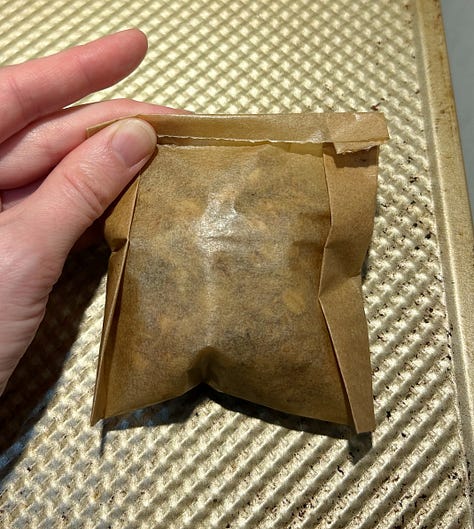
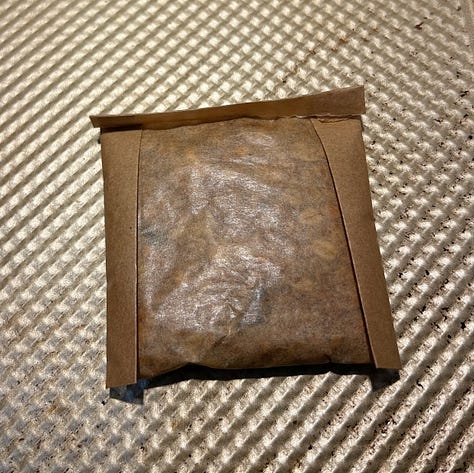
Know someone who would enjoy Letters from the Table?
Send them an invitation to our newsletter. We are thankful for each and every reader of our work, so we set up a referral program to thank you for any friends you send our way. For each new subscriber, we’ll gift you a month of paid content.
Resources for Creators and New Beginnings
Making big new changes is often less about desiring an outcome than developing the mindset and skillset to get there. It takes create the space for change, work towards it, and find the support you need to get there.
Find inspiration to grow with Hidden Potential by Adam Grant: It isn’t too late to start. It isn’t too late to change. Adam Grant’s book interrogates the value of talent versus the mindsets and skills needed to learn, grow, improve, and develop hidden potential.
Strip back to the essentials with The New Happy by Stephanie Harrison: What do you value? Do you know what will make you happy? Do we act in ways that will make us happy? Stephanie Harrison’s decade's worth of research set out to answer just that and has become a growing body of work through her viral social media posts, book, podcast, and tools that help you find true happiness in your life by helping other people to live happier lives.
Create mental space and a solid foundation for new beginnings with Open: Open is a breathwork, meditation, and movement studio and app, based out of LA. Their meditation and breathwork sessions have become a grounding daily routine that helps me see through my mental clutter and find the space to be more present with the moment and focused. I love their several day programs for building a regular practice around mental and emotional health goals. Try their free 21 Day Nervous System Reset to begin 2025 with a solid foundation for a healthy body and mind.
Create an actionable vision for the future and harness neuroscience (and a dose of woo-woo) to achieve it with The Source by Dr. Tara Swart: Do you like the idea of vision boards, but can’t help rolling your eyes at the woo-woo? Same. My practical side seeks data-based evidence and structure with any advice for moving forward. Dr. Tara Swart is a Psychiatrist, Neuroscientist, and lecturer at MIT whose evidence-based approach to manifesting (aka creating change) convinced me to give Action Boarding (her action-oriented version of Vision Boards) a try. I paired it with values-based exercises from Stephanie Harris and Brene Brown to create a personal vision of a future that is deeply grounded in my values.
Build your creative practice and a routine that works with advice from other artists and creative folks.
The Artist’s Way by Julia Cameron: This is a classic text for building a sustainable creative process.
The War of Art by Steven Pressfield: Another classic, The War of Art, gives sound advice to keep pushing through the resistance that you’ll inevitably find along the way in creating your art.
Keep Going by Austin Kleon: I love Austin’s text-based artwork. His advice on creative work is equally simple and refreshing. In his words, “I wrote this book because I needed to read it.”
Art Spaces in Long Island City (Queens, NYC)
Long Island City has changed so much since 2007. Industrial warehouses and art spaces were demolished in favor of shiny new highrises and corporate buildings. 5Pointz was a prominent casualty when the building owner decided to demolish and develop the site in 2013 — whitewashing the intentionally curated street art and murals on the building’s exterior overnight. While finding an affordable, raw artists’ live/work space in LIC is increasingly unlikely, there are several wonderful art organizations worth visiting for taste of the community spirit among the artists living and working here, including the examples below.
MoMA PS1: MoMA’s home for experimental and site-specific installation art, PS1 is a former public school transformed into an artspace during the 70s as a part of the alternative space movement, a foundation for the generations of NYC artists since then establishing art spaces and exhibitions in repurposed spaces. Visit during the summer for Warm Up, their signature annual outdoor music series and neighborhood parties.
Flux Factory: Flux Factory began in 1994 as an art space in a Williamsburg warehouse space. Priced out of that space and then another in Sunnyside, they finally landed in LIC. They continue today in supporting emerging artists and the NYC art community.
Socrates Sculpture Park: Socrates Sculpture Park was established by a group of artists in 1986, transforming an abandoned riverside landfill into a public garden and art exhibition space. They support the art community featuring work from artists from early-career to internationally renown. And they nurture the local community with free admission and a variety of community programs.
The Noguchi Museum: While each of the previous examples focused on art spaces founded by groups of artists in community, The Noguchi Museum is a notable cornerstone of the local art scene because of Isamu Noguchi’s vision to transform an abandoned factory space into a showcase for his life’s work. Over decades, from when he first established his LIC studio in 1961, he transformed the space into the first US museum designed and established by a living artist to showcase their work.
Do you have a memory you would like to share?
Let’s talk about sharing your story through a love letter and recipe in a future volume.


